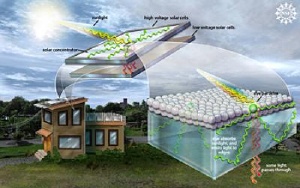Jul 11 2008
Revisiting a once-abandoned technique, engineers at the Massachusetts Institute of Technology (MIT) have successfully created a sophisticated, yet affordable, method to turn ordinary glass into a high-tech solar concentrator.
 An artist's representation shows how a cost-effective solar concentrator could help make existing solar panels more efficient. The dye-based luminescent solar concentrator functions without the use of tracking or cooling systems, greatly reducing the overall cost compared to other concentrator technology. Dye molecules coated on glass absorb sunlight, and re-emit it at a different wavelengths. The light is trapped and transported within the glass until it is captured by solar cells at the edge. Some light passes through the concentrator, and is absorbed by lower voltage solar cells underneath. [Note: Graphic is not to scale.]Credit: Nicolle Rager Fuller, NSF
An artist's representation shows how a cost-effective solar concentrator could help make existing solar panels more efficient. The dye-based luminescent solar concentrator functions without the use of tracking or cooling systems, greatly reducing the overall cost compared to other concentrator technology. Dye molecules coated on glass absorb sunlight, and re-emit it at a different wavelengths. The light is trapped and transported within the glass until it is captured by solar cells at the edge. Some light passes through the concentrator, and is absorbed by lower voltage solar cells underneath. [Note: Graphic is not to scale.]Credit: Nicolle Rager Fuller, NSF
The technology, which uses dye-coated glass to collect and channel photons otherwise lost from a solar panel's surface, could eventually enable an office building to draw energy from its tinted windows as well as its roof.
Electrical engineer Marc Baldo, his graduate students Michael Currie, Jon Mapel and Timothy Heidel, and postdoctoral associate Shalom Goffri, announced their findings in the July 11 issue of Science.
"We think this is a practical technology for reducing the cost of solar power," said Baldo.
The researchers coated glass panels with layers of two or more light-capturing dyes. The dyes absorbed incoming light and then re-emitted the energy into the glass, which served as a conduit to channel the light to solar cells along the panels' edges. The dyes can vary from bright colors to chemicals that are mostly transparent to visible light.
Because the edges of the glass panels are so thin, far less semiconductor material is needed to collect the light energy and convert that energy into electricity.
"Solar cells generate at least ten times more power when attached to the concentrator," added Baldo.
Because the starting materials are affordable, relatively easy to scale up beyond a laboratory setting, and easy to retrofit to existing solar panels, the researchers believe the technology could find its way to the marketplace within three years.
The new technology emerged in part from an NSF Nanoscale Interdisciplinary Research Team effort to transfer the capabilities of photosynthesis to solar technology.
The researchers' approach succeeded where efforts from the 1970s failed because the thin, concentrated layer of dyes on glass is more effective than the alternative--a low concentration of dyes in plastic--at channeling most of the light all the way to the panel edges. However, the current technology still needs further development to create a system that will last the 20- to 30-year lifetime necessary for a commercial product.